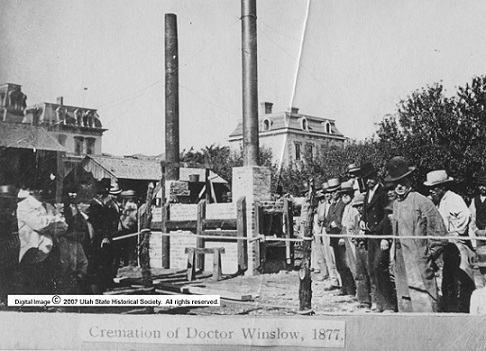Dublin Core
Title
Description
In 1877, a cremation was scheduled to take place in Salt Lake City. The body to be burned was Charles F. Winslow's, a doctor from Boston, Massachusetts, who died of heart failure earlier that week on July 7th.
When Winslow's friends read his will the day he died, they discovered he wanted his body to be burned and his ashes placed in his late wife's coffin, so they had a special furnace built just for the occasion and announced that the doctor's remains would be burned the next Thursday. But his children interfered, and threatened to sue, forcing the ceremony to be put on hold until things could be ironed out and a new date—July 31st—could be set.
Winslow's cremation ended up being a first-rate spectacle. Police were on hand to cordon off the furnace and keep out the mob of curious onlookers that showed up to watch. Some people even jumped the barricade to get a closer look. Here's how the Salt Lake Tribune described what happened shortly after the doctor's body was finally fed into the blazing crematory:
"For the first twenty-five minutes the body could not be seen on account of the density of the smoke and flames which surrounded it, but a crackling noise was quite distinct. By the expiration of the first half hour only the roar of the fire was heard, and the bones of the lower extremities became visible, the flesh having entirely disappeared."
The fire was stoked again and a little more than two hours later Winslow's body was gone, reduced to a few pounds of fine white ash.
The irony of Winslow's burning—only the second formal cremation in modern American history—was that it happened in a conservative state where today some people question the dominant religion's stance on cremation. Yet, this important episode in the development of the national cremation movement was hardly noticed by the church. No denunciations in the Deseret News, no statements from the First Presidency—just a quiet acceptance of a new way of departing this world.
In fact, it wasn't until seven years later that the Mormon-owned Deseret News actually started encouraging church members to reject cremation, and then only for health—rather than religious—reasons.
Creator
Source
Image: Crematory, Salt Lake City, UT. Caption reads: Cremation of Doctor Winslow, 1877. Image shows the first crematory in Salt Lake City. It was reported on in the Deseret News on 11 July 1877, located inside the block between South Temple and 1st South and between Main Street and State Stree. Courtesy of Utah State Historical Society.
_______________
See news reports about the Winslow cremation in the following editions of the Salt Lake Tribune: July 12, 1877; July 13, 1877; July 31, 1877; August 1, 1877; and August 2, 1877. Two retrospective news stories were also done on the Winslow cremation and can be found in the May 15, 1895, and August 6, 1899, editions of the Tribune. Also see Stephen Prothero: Purified by Fire: A History of Cremation in America (Berkeley: University of California Press, 2001).

